

 The South African
The South African
In the closing days of World War II, against the backdrop of a crumbling Nazi Germany, a little-known and extraordinary event unfolded within the heart of the Austrian Alps. This remarkable event, often overshadowed by the surrender of Germany mere days later, took place in the medieval fortress of Schloss Itter, nestled deep within the northern Tyrol region of Austria. Schloss Itter, with its centuries-old foundations, had witnessed the ebb and flow of history until its seizure by the SS in 1943, when it became a part of the infamous Dachau Concentration Camp system.
This fortress would serve as an unlikely crucible, bringing together a diverse group of individuals - high-profile French politicians, generals, a tennis legend, and others - who, despite their personal and political differences, found themselves united by a common peril: their captivity by the Nazis. Edouard Daladier was Prime Minister at the start of World War 2 and is known for signing the Munich Agreement that gave Germany the Sudetenland in Czechoslovakia. Paul Reynaud was Prime Minister during the Battle of France - and hated Daladier. Maurice Gamelin was known for his disastrous command of the French Military during the German invasion of France. Maxime Weygand was appointed Gamelin's successor near the end of the battle, surrendered to Germany and then collaborated with them in the Vichy Government. Francois De La Rocque was a right-wing leader of Croix de Feu and a closet member of the French Resistance while Leon Jouhaux was a trade union leader. As the Allied forces closed in on the German homeland, the fate of these prisoners became increasingly precarious, as there were legitimate concerns that they might be assassinated by the Waffen SS.
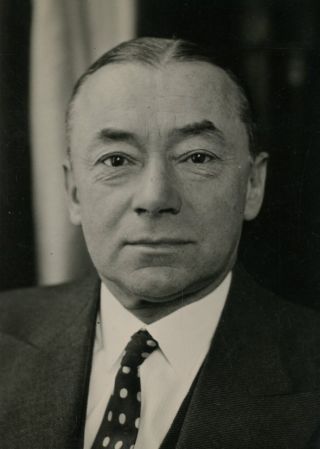
Paul Reynard
The Red Army marched deep into Hungary from the east. German forces had surrendered in Italy to the south and the western allies advanced towards Tyrol from the west. What was left of the shattered remnants of the German army flooded back into Austria and Tyrol grew full of the last die-hard Wehrmacht and Waffen SS troops whose mere presence would keep many other soldiers from surrendering. However, there was also another group there that is always overlooked: the Austrian Resistance.
After the Anschluss in 1938, there had always been a number of native Austrians who stood against the Germans. For many years, they could only offer passive and non-violent opposition, but with the Allies just a few miles away, they could finally act. They provided valuable intelligence about the German defences and directed the army spearheads through the Inn River valley, but their most important goal was to protect the Austrian citizens from bloody reprisal by the SS. Already people were hanging white and Austrian flags out from their windows. The SS did not hesitate to open fire on these defeatists.
With the end of the war in sight, the French prisoners started to discuss what they could do to save themselves since just walking out of the castle without the Americans in sight would be suicide. But they then decided to get in contact with a very unlikely person, Waffen SS Captain Kurt-Siegfried Schrader. One might ask why contact someone that would execute them, for he was a highly decorated officer and served as part of Hitler's bodyguard in his headquarters. Well, after being badly wounded fighting in France, he broke all ties with the Nazis and defected to the side of the Austrian Resistance. They made contact with him, and he promised to help them, but he knew that on his authority alone he could only buy them some time. The prisoners agreed that without American help, they would never be free or get out the castle alive.
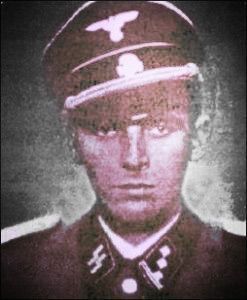
Waffen SS Captain
Kurt-Siegfried Schrader
After long and hard discussions, they decided to send for the Americans. On 3 May 1945, a Yugoslav communist resistance member from Croatia smuggled a broken English letter out of the castle while running an errand for prison commander Sebastian Wimmer. He found Americans on the outskirts of Innsbruck, but on the way to the castle, the superiors recalled the forces for encroaching into territory of the US 36th Division. When he failed to return to the castle with troops the next day, a Czech cook volunteered to find the Americans. Halfway to the American lines lay the town of Wörgl. While biking through the town, desperately trying to prevent running into Waffen SS, he was pulled into a house. This saved his life as a Waffen SS patrol almost spotted him. His saviour was Major Josef Gangl, a major of the Wehrmacht. Gangl had been a career soldier since 1935. His war consisted of Stalingrad, Normandy, and Bastogne. Gangl had seen everything, but he had returned a disillusioned man, and like Schrader, chose to betray his oath to the Nazis. The cook told him about the Castle and the people within and the two set off by car to find the nearest Americans.
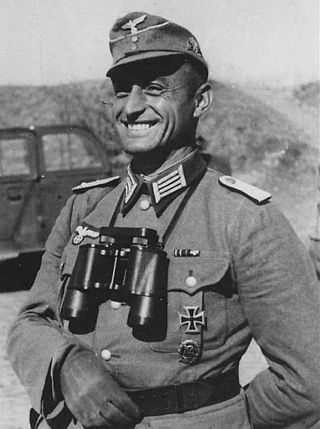
Wehrmacht Major Josef Gangl
In the village of Kufstein, they spotted four Sherman tanks. The Americans grabbed their M3.s and aimed them at the Germans. The Americans were suspicious of them since many Germans were surrendering, but sometimes SS men had been known to disguise themselves, to take some Americans out with them. The vehicle came to a halt in front of the Americans who were holding their guns at the heads of the Germans. The cook gave the Americans the letter the prisoners had written.
Captain Jack Lee, a stocky 27-year-old from Norwich, New York, was sitting on his Sherman tank (nicknamed Besotten Jenny) when the vehicle arrived. For the last five months, Lee had led Company B of the 23rd Tank Battalion on a headlong advance across France, into Germany and now into Austria. Just like all the Allied soldiers on the Western Front, Lee knew the war would end in the coming days with the Red Army's push into Berlin. When the two men told him about the castle, he was hesitant at first, but when he radioed his superiors and they gave him the green light, he was ecstatic. The former college football star rallied his men and set off with his ad hoc task force of seven Shermans. His own tank, Besotten Jenny, took the lead.
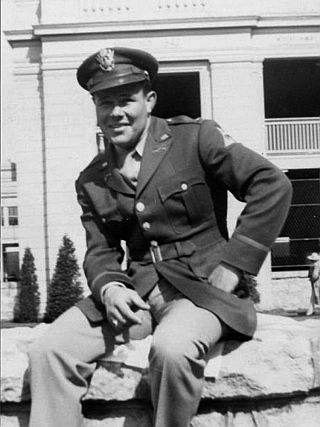
United States Army Captain Jack Lee
The journey to Castle Itter was not an easy one. They had to make their way to Wörgl to pick up the rest of Gangl's men in case they had to help fight. They arrived at a wooden bridge. It was the only potential obstacle between them and the town of Wörgl. The men made their way over it first and the tanks followed. Besotten Jenny and another tank, Boche Buster, led the tanks over the bridge. Two tanks followed them to the other side of the river - then it collapsed. Lee then ordered the tanks that failed to make it back to where they came from. Once in Wörgl, Lee picked up Gangl's men and they continued their journey to the castle. Lee also ordered the two tanks that followed Jenny and Buster to remain in the town to help the Austrian Resistance, who had welcomed them with open arms. On their way to the castle, they reached another bridge. This time Lee ordered Boche Buster to stay behind to protect their way back into town. Now commanding 1 tank, 7 Americans and about 10 German soldiers, Lee and Gangl reached Castle Itter. Captain Lee felt uneasy about working with a Waffen SS officer, but they all put their differences aside and headed into the castle. They were greeted with disgust by the French who had expected more soldiers. It is said that Gangl tried his best to be polite to the French but according to Paul Reynaud, Lee was seen as "Crude in both looks and manners and if Lee is a reflection of America's policies, Europe is in for a hard time".
In the castle, perhaps one of the most unlikely scenes of the war took place. An American Army Captain, a Waffen SS Officer and a Wehrmacht Major were forming a grand coalition and planning to defend French hostages from loyal Nazis in a medieval Austrian castle.
They compiled a list of the hostages, reversed Jenny into the main gate to block the entrance from anyone that tried to invade the castle and positioned their men around the castle, giving orders to the soldiers on where to position themselves.
Lee believed that they would be able to hold out for a long time behind the thick castle walls. This was just a theory though. At 23:00, Lee spotted Waffen SS troops in the distance. Deafening cracks of anti-tank guns shook the castle. The windows shattered as SS machine guns fired through them. A German mg42 fired at the gatehouse and Jenny's 50 calibre answered. Tracer rounds were flying through the dark. Lee and Gangl's men rushed to their prearranged positions and returned fire.
The German soldiers spotted Waffen SS carrying grappling hooks. The SS wanted to climb up into the castle, but the guns of the Germans and Americans on the western wall were foiling their plan. Trust between the Americans and Germans had been shaky at best since the Americans didn't feel like fighting alongside Germans who had tried to kill them ever since they landed in France, but now none of that mattered because none of them would survive if the SS were to get inside the castle.
Gunfire came from behind the soldiers on the walls as the French prisoners rushed to help their saviours. A grenade came flying into the castle. Everyone ducked, but tennis player Jean Borotra had swung his tennis racket, and the grenade went flying back at the SS.
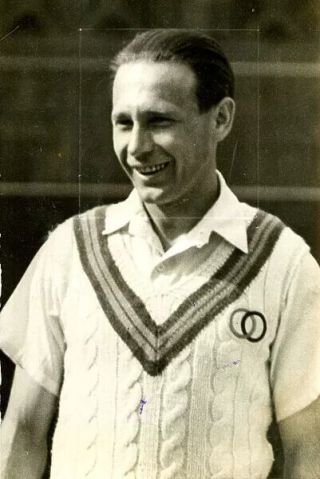
Jean Borotra
Shortly after 08:30, the battle got real. The Germans and Americans on the wall had spotted truckloads of SS soldiers arriving to aid those who had started fighting a few hours earlier.
An 88mm anti-tank gun lobbed a shell into the upper floor of the main building. Moments later a second 88mm round slammed into Jenny. The corporal that was manning the tank leaped from her just in time, as Jenny turned into an inferno. Jenny was no more. Her destruction meant that the SS could now push into the castle. SS troops swarmed from the tree line to the east, sprinting towards the castle's main gate. Others began scrambling up the hill on the west, trying to reach the relative cover of the lower walls.
The additional French were few, but it did add some numbers to the alliance. The French prisoners were firing violently at the SS soldiers outside the castle. The elderly Reynaud fired an mp40 through a broken window. Knowing that he had agreed with Lee and Schrader that no French prisoner would be killed, Josef Gangl ran over and pulled him to the ground as he was dangerously exposed.
In doing so, the German Major, who had survived the war in Europe from its start to the final battle, unwittingly sacrificed his own life to save that of a French politician, because a sniper had been taking aim at Reynaud at the very moment Gangle tackled him to the ground.
With more 88mm rounds smashing into the castle, there was no time to mourn their first death, so the alliance fought on. Since Besotten Jenny was blown up, the SS had broken through her wreckage and were advancing towards the large doors. During the fighting, the defenders' only radio had been broken, but Schrader remembered where the castle telephone was and directed Lee to it to call for assistance. Alois Myer, the leader of the Resistance in Wörgl, answered the call and Lee asked for reinforcements. With Gangl's death, Lee had taken over sole command of the coalition. Then Borotra ran from the walls where he had been firing at the SS and put a plan to Lee. Borotra offered to vault the walls of the castle and run towards Wörgl to fetch the reinforcements. Lee agreed and Borotra found some Austrian peasant clothes in the castle, vaulted over the walls and bolted into the forest. He immediately stumbled upon 2 SS soldiers manning a machine gun. To the absolute astonishment of the soldiers, Borotra stuck with his disguise and started picking mushrooms and putting them in his pockets. He relieved himself against a tree and waved them goodbye.
By noon, the alliance was almost out of ammunition. Lee couldn't wait for Borotra to return and began to re-evaluate his plan. Castle Itter was a medieval castle and in line with medieval military practice, Lee ordered the coalition to withdraw into the castle's massive keep. They would then use their few remaining rounds of ammunition, their bayonets, and if necessary, their fists, to make the SS men fight for every final inch of the fortress.
Sensing victory, the SS troops pressed their assault on the castle's keep's entrance. A squad of soldiers prepared an anti-tank rocket to shoot the entrance open when automatic weapons and tanks guns behind them in the village signalled a radical change in the battle. The cry "Amerikanische panzer" echoed across the castle as the Boche Buster rolled up to where Jenny lay destroyed. The Battle of Castle Itter was over - the coalition had won.
While the coalition was busy tending to the wounded German soldiers in the castle, the French politicians and generals were put in a truck and escorted to Paris to help rebuild the liberated nation. For Lee and his men, the battle's aftermath was more anti-climactic. The Americans and the Wehrmacht soldiers all piled unceremoniously into the back of a truck and rode back to Kufstein. The Germans were then marched off to a POW camp.
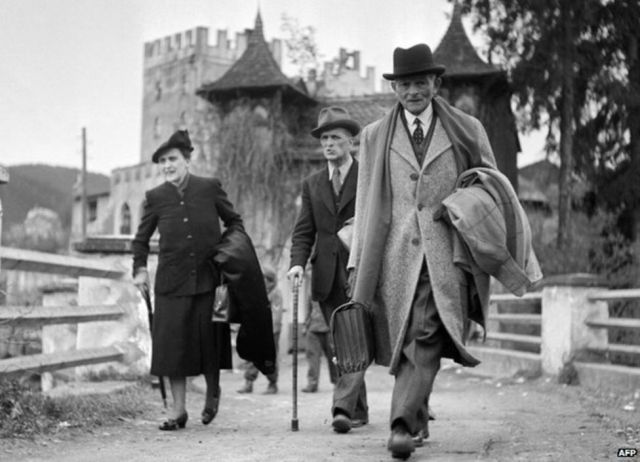
French General Maxime Weygandleaves the Schloss in 1945
For his valiant effort, Lee was awarded the Distinguished Service Cross. Josef Gangl would be honoured in Austria as an Austrian National Hero and a street in Wörgl was named after him. As an SS captain, Schrader would be arrested and imprisoned for 2 years after the war, a somewhat lesser punishment since he had helped defend the castle.
While the unusual circumstances of the action at Castle Itter made it the subject of a few newspaper and magazine articles, including a July 1945 piece in the Saturday Evening Post, Lee himself summed it up best. A few months before his death in January 1973, he was asked by a reporter in Norwich how he felt about the long-ago incident. Lee thought for a minute, then replied, "well, it was just the damnedest thing".
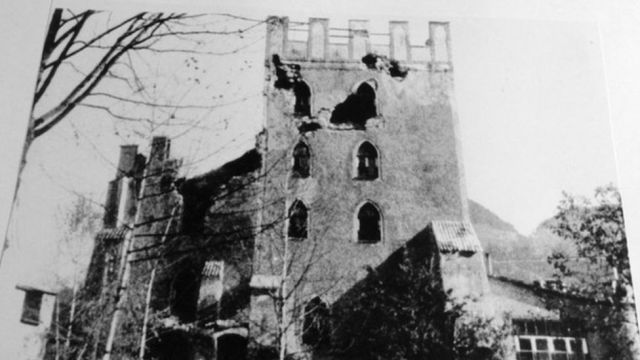
Damaged Castle Itter
BIBLIOGRAPHY
Antón, J. (2023) The World War II battle where German and US soldiers joined forces against the Waffen-SS, EL PAÍS English. Available online
Bell, B. (2015) The Austrian Castle where Nazis lost to German-US Force, BBC News. Available online.
Harding, S. (2016) The battle for castle Itter, HistoryNet. Available online.
Neikirk, T. (2022) When German and American troops joined forces against the SS: The battle of castle Itter, warhistoryonline. Available online
Pendavingh, R. (2020) The battle for Schloss Itter, The Unravel. Available online
Walsh, R. (2017) The battle for castle Itter: The strangest battle of WWII
About the author
Dylan is a post-grad student studying for his PGCE through the North West University in 2024, in order to not only teach but inspire the love of history inhigh school learners.
He completed his 3 year Bachelor's Degree in History and English in 2023.
He has made several Zoominar presentations for SAMHSEC (Military History Society's Eastern Cape Branch) and in-person lectures for the Ancient History Society on various peculiar historical topics, as well as two memorabilia showcases in his History class at NMU.
Return to Journal Index OR Society's Home page
South African Military History Society / scribe@samilitaryhistory.org